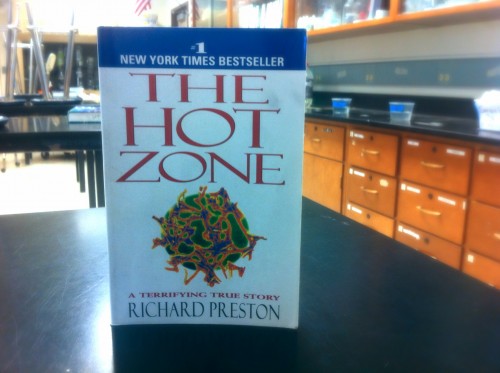Story by Aditi Desai and Neha Patchipala
IHot Zone,t was ten years ago when science teacher Andrew Goldenkranz met the author of the
Richard Preston. After a year of CDC meetings, hours of written work, and countless meetings with Preston, Goldenkranz achieved his final product: the study guide.
Science teacher Andrew Goldenkranz wrote a study guide along with scientist Richard Preston to accompany The Hot Zone, a non-fiction book written in 1995 by Preston. The book is a report of the Ebola virus and its appearance in Washington D.C., which describes the experiences of the victims and maps the origins of this deadly disease.
The study guide analyzes and questions the events that occur in The Hot Zone in an organized fashion and helps readers understand and compare different current issues pertaining to the curriculum, making use of visual resources such as diagrams, maps, video tours and pictures. For example, the study guide includes a video tour of the Hazmat unit in a hospital.
“I realized, as a science teacher, that I was just always curious about books kids were reading for fun,” Goldenkranz said. “I saw that these kids were just [attached to] this book and I immediately realized there was a teachable moment in there for a science teacher”.

The resource was designed so that it could be implemented in literature classrooms as well, as the study guide asks readers to think about why the narrator perspective shifts from first person to second person in certain sections. English teachers can use this as a resource in lessons about point of view.
Due to the recent Ebola outbreak, Goldenkranz has received more requests for this resource, eventually pushing him to publish the guide online. During the initial release of the study guide, it was introduced into the curricula of over 1000 schools across the country. In particular, it has been widely used in Georgia, the location of the Center for Disease Control and Prevention.
Goldenkranz has recently incorporated his study guide into his APES curriculum by reading passages from the book related to the dangers and effects of connection with Ebola victims in airplanes and other public areas. The study guide ties into the unit his APES classes have just started: public health and toxicology.
Senior Andrea Pappas, who is currently taking Goldenkranz’s APES class, said that the implementation of a study guide will benefit many students, since a study guide that breaks down the book and certain concepts will help students conserve time.
Pappas believes that the labs, projects and questions that help break up the chapters of the book will help students gain a better understanding of the material taught.
“When you’re getting hands on with something… the material really stays with you”, Pappas said. “You can clearly remember I did this because of that [step]”.
Goldenkranz uses his study guide as a reference for questions, or a “recipe guide,” when discussing certain main issues that relate to the specific units studied in class. For example, the case of an Ebola outbreak might relate to an antibiotic resistance lab, which consists of a brief introduction into the culture of vaccines. It also examines airline schedules and makes the reader think about how the Ebola virus can spread very quickly. By picking out aspects of the study guide that pertain to the issue, Goldenkranz hopes to apply a multidisciplinary approach to teaching.
By giving an additional resource to his students, the aim of the study guide is to be perceived as more effective. Senior Sasha Rubinshteyn, who is also currently taking Goldenkranz’s APES course believes that the study guide will prove to be useful for her.
“The study guide would be really useful [in] having a more descriptive definition of what we need to know”.
For more about Ebola, read this article.







